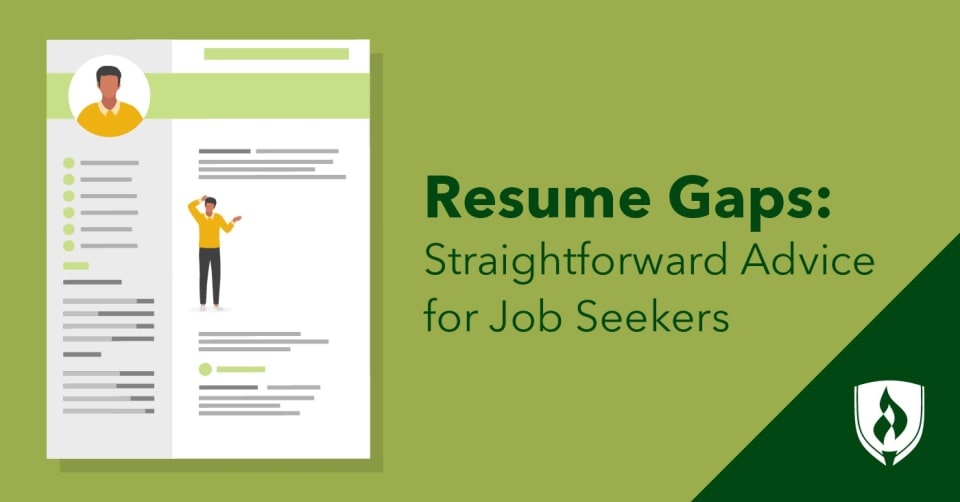After some time out of the workforce, you’re ready to jump back into a job, hunting for openings and updating your resume. But now you’re stuck figuring out how to best handle a resume gap.

With your potential perfect job on the line, worrying about what employers will think about the employment gap is totally understandable. Will they suspect the worst? What’s the best way to explain a gap in your resume? Can you address the issue without drawing negative attention to it? These are some tough questions to wrangle with, particularly when the answers can be very consequential.
Don’t let not knowing how to address employment gaps on your resume be what stops you from getting the big job. Whatever the reason for your resume gaps, we’ve got advice and answers for your pressing concerns.
How to handle an employment gap in your resume
Stay calm and create a strategy
Before you worry too much about how to explain the gap in your resume, remember that you’re not the only one with an employment gap. It’s a fairly common occurrence, and recent events have almost certainly added to the ranks of professionals with employment gaps to account for.
Elizabeth Lintelman, director of Career Services at Rasmussen University, explains that the COVID-19 pandemic created employment gaps for many, whether it’s from being laid off, their company closing or needing to adjust life schedules to provide childcare. Many people are still experiencing this as conditions continue to fluctuate.
Additionally, Lintelman notes that while workers used to stay with one company for their whole career, people now change jobs and companies much more frequently, often creating employment gaps on their resume. With this comes changed perceptions, as the occasional gap isn’t necessarily a red flag for employers.
However, just because you’re in company doesn’t mean that you can completely ignore the employment gap on your resume. Thinking through how you address the gap in an interview or on your resume will set you up for a smooth and confident job search.
Be honest
While adding jobs or altering dates on your resume can eliminate an employment gap, doing so can seriously hurt your chances at employment. “[The] most important piece of advice is that you have to be honest,” says Lintelman. “Do not falsify dates of employment on your resume or job applications.”
She explains that employers will often verify an applicant’s work history, catching any potential falsifications. While an employment gap can be explained, lying on a resume is a serious red flag for employers.
Think of it this way—lying about your employment history is an almost certain disqualification, while telling the truth (even if the truth isn’t ideal) isn’t necessarily a dealbreaker for employers.
Think beyond traditional paying jobs
Even while being honest, there are still ways to eliminate or minimize a resume gap. When you are updating your resume and constructing a cover letter, Lintelman recommends thinking about your experiences in a new light. The result may be that your resume gap is not as much of a gap as you expected.
Your credentials are not limited to the narrow scope of traditional paying jobs. Experiences outside of the office can be just as valuable as the time you spend in the workplace.
Think about the period of your resume gap and consider how you spent your time. As Lintelman says, “Applicants have to start thinking about their skills and abilities by considering projects and initiatives taken in their personal lives, such as within the classroom, within personal or professional groups or in volunteer work, just to name a few.”
The key is to demonstrate the relevance of these experiences: When describing your experiences, keep in mind how they can apply to the job you are seeking and how they benefit a potential employer.
"Chances are you have so much value to bring to an employer, you just have to know how to position it."
“It’s important to remember that your abilities and self-worth are not limited to your resume,” says Lintelman. “Chances are you have so much value to bring to an employer, you just have to know how to position it!”
Leverage your skills from the gap
As you’re thinking how to present these experiences, consider what skills you used or learned. Even though you weren’t working a traditional job, you still likely developed important skills during a resume gap. With the experiences that you identify from that time, you can break them down into skills that will be valuable for the job you’re applying for.
If you’re struggling with where to start, look at job descriptions and see what skills the company lists. You may realize that during the time of your resume gap, you developed or honed some of these, especially soft skills.
For instance, if you were acting as a caretaker for your child or an aging parent, you probably had to multi-task and keep organized—these are both skill sets you can mention. And if you went back to school, you obviously have a whole new set of skills to mention.
Even if you didn’t intentionally take that much time off—like if you were let go from your previous position—you can still analyze what you did with your time in the gap and find some potential skills to leverage.
“Employers look for applicants who can illustrate their problem-solving abilities and willingness to be a continual learner,” says Lintelman. “Perhaps you weren’t employed for six months, but perhaps you took the initiative to learn a new skill or take a class to enhance your knowledge about a particular industry.”
Beyond resume gaps: Job search advice
With this advice, you can explain the gap in your resume with confidence. Whether it’s leveraging your unique skill set or discovering you have more experience than you think, you’re ready to impress employers with your qualifications without your resume gaps holding you back.
And now that you’ve conquered the employment gaps on your resume, the rest of the job search awaits. With all the moving parts, it’s normal to have some doubts about landing that dream job. If you’re ready for some more practical tips, read our article “Job Search Advice: 10 Tips for Taking the Next Step” to master the other aspects of the job hunt.




